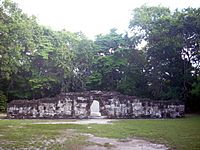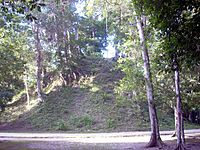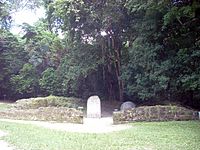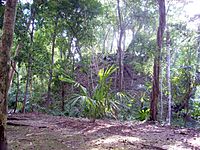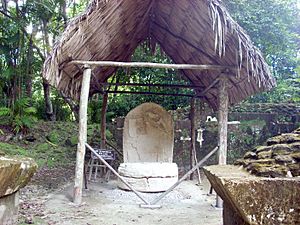Twin-pyramid complex facts for kids
A twin-pyramid complex was a special type of building created by the ancient Mayan civilization in Mesoamerica. These unique groups of buildings were regularly constructed in the large Maya city of Tikal in Guatemala. They were built to celebrate the end of a 20-year period called a kʼatun cycle in the Maya Long Count Calendar.
Twin-pyramid complexes have also been found in other cities like Yaxha, which is about 30 kilometers (19 miles) southeast of Tikal. Another one was found at Ixlu, and Zacpeten also seems to have at least one, possibly two. Finding these complexes outside of Tikal suggests that these cities were closely connected to Tikal politically.
The basic design of a twin-pyramid complex includes two identical pyramids. These pyramids are located on the east and west sides of a small open area called a plaza. To the north, there's a walled area that holds a carved stela (a tall stone slab) and an altar. On the south side, there's a long building. Plain monuments were usually placed at the base of the east pyramid. The name "twin-pyramid complex" was first used in 1956 by Edwin M. Shook. He noticed that five such groups shared a similar building style.
Contents
What Did Twin-Pyramid Complexes Look Like?
Twin-pyramid complexes featured two identical pyramids, one on the east and one on the west side of a small plaza. Each pyramid had stairways going up all four of its sides.
Usually, there was a long building on the south side with nine doorways. On the north side, there was a small, walled area. This northern area held a carved stela and an altar. These carved monuments often showed the king performing the ceremony to mark the end of the kʼatun cycle.
Up to nine plain stelae and altars were set up in a line at the base of the eastern pyramid, facing west. At Tikal, no stelae were ever placed in front of the western pyramid. The entire twin-pyramid complex might have been a smaller version of Tikal's Great Plaza. It copied the layout with pyramids on the east and west, a special shrine to the north, and a simple palace to the south. The twin pyramids were never meant to have a temple on top.
The walled northern enclosure faced south towards the plaza. You could enter through a single doorway with a corbel arch (a special type of arch). This enclosure did not have a roof.
Where Were They Built?
The very first twin-pyramid complex was built in Tikal's East Plaza in the early 500s AD. This first one was used to celebrate several kʼatun endings. During the Late Classic Period (around AD 600–900), a new twin-pyramid complex was built for each kʼatun-ending ceremony. Six complexes were built between 692 and 790 AD.
A total of nine such complexes have been found at Tikal. However, one was completely taken apart a long time ago, and others were partly dismantled. Later twin-pyramid complexes tended to be larger than the earlier ones.
| Site | Group | Date (AD) | Kʼatun |
|---|---|---|---|
| Ixlu | North Plaza | Classic | |
| Tikal | Group L (Group 5B-1) | 672 | 9.12.0.0.0 |
| Tikal | Group M (Group 3D-1) | 692 | 9.13.0.0.0 |
| Tikal | Group N (Group 5C-1) | 711 | 9.14.0.0.0 |
| Tikal | Group O (Group 4D-1) | 731 | 9.15.0.0.0 |
| Tikal | Group P (Group 3D-2) | 751 | 9.16.0.0.0 |
| Tikal | Group Q (Group 4E-4) | 771 | 9.17.0.0.0 |
| Tikal | Group R (Group 4E-3) | 790 | 9.18.0.0.0 |
| Tikal | Group 4D-2 | ||
| Tikal | Group 5E-Sub.1 | ||
| Yaxha | Plaza A | 793 | |
| Zacpeten | Group A | Late–Terminal Classic | |
| Zacpeten | Group B | Late–Terminal Classic |
Twin-Pyramid Complexes at Tikal
Before 1956, five of the nine twin-pyramid complexes at Tikal had already been found. Four were reported by Teoberto Maler in 1911 and mapped that same year. The last one was discovered by Edwin Shook in 1937. When Shook found Stela 22 in Group Q in 1956, he realized that all five groups followed a specific building pattern. He then created the term "twin-pyramid complex" to describe them.
Tikal Group L (also known as Group 5B-1) was located south of Tikal Temple IV. It was taken apart a long time ago. Archaeologists believe it was demolished around 740 AD to get building materials for Temple IV. What remains are some plain monuments scattered on the ground. The northern enclosure is gone, but it once held a plain stela and altar (Stela P-41 and Altar P-43). This complex was likely built in 672 AD.
Tikal Group M (also known as Group 3D-1) is west of Group P. The west pyramid (Structure 3D-98) was mostly taken apart in ancient times. Three plain stelae were placed in front of the east pyramid (Structure 3D-100). The northern enclosure is not well preserved, but it still contains Stela 30 and Altar 14. These monuments are dated to 692 AD. Group M was found during mapping by the Tikal Project in 1959. It was confirmed as a twin-pyramid group when its northern enclosure was uncovered in 1961.
Tikal Group N (also known as Group 5C-1) is located between Tikal Temple IV and the Bat Palace. It was built in 711 AD. This date comes from the hieroglyphic text carved on Stela 16 in the group. Stela 16 is paired with Altar 5. They are some of the best examples of carved monuments from Tikal. Both are in the northern enclosure. Altar 5 shows two important people on its top, one of whom is probably Jasaw Chan Kʼawiil I. They are performing a ritual using the bones of an important woman. Stela 16 is carved only on its front, showing a picture of king Jasaw Chan K'awiil I and a text.
Tikal Group O (also known as Group 4D-1) is on the west side of the Maler Causeway. It is different in size from the twin-pyramid groups to the east. Unusually, the stela and altar in its northern enclosure are plain, meaning they have no carvings or text. This group was probably dedicated in 731 AD.
Tikal Group P (also known as Group 3D-2) is at the very north end of the main site. Its pyramids have been dug up and partly restored. The northern enclosure held Stela 20 and Altar 8. It was dedicated in 751 AD. Both monuments are now in the Museo Nacional de Arqueología y Etnología in Guatemala City.
Tikal Group Q (also known as Group 4E-4) is east of Group R. It is the largest twin-pyramid complex at Tikal. It was connected to king Yax Nuun Ahiin II, who is shown on Stela 22. Stela 22 and Altar 10 are excellent examples of Late Classic Maya sculpture, even though the carved figure was damaged a long time ago. The group has been mostly restored, with its monuments put back up. The east pyramid, north enclosure, and south building have also been restored. Group Q dates to 771 AD.
Tikal Group R (also known as Group 4E-3) is on the east side of the Maler Causeway. Stela 19 and Altar 6 are in the northern enclosure. The text on the stela dates the complex to 790 AD. One of the plain stelae that was in front of the east pyramid is missing. The altar that went with it has been moved from its original spot. Digs show that people living in the area moved the stela and altar during the Postclassic period (AD 900–1525).
Tikal Group 4D-2 had two monuments that suggested it was a badly damaged twin-pyramid group.
Tikal Group 5E-Sub.1 was found in 1965 by Christopher Jones. It was discovered during digs of a ballcourt built on top of it. The style and locations of its two pyramids showed it was one of Tikal's twin-pyramid complexes.
Twin-Pyramid Complexes at Ixlu
The city of Ixlu has a twin-pyramid complex in its North Plaza. This complex dates back to the Classic Period.
Twin-Pyramid Complexes at Yaxha
Yaxha Plaza A is a twin-pyramid complex located just north of its East Acropolis. A carved stela was placed at the base of the West Pyramid. This Stela 13 was carved but has broken into pieces, though much of the carving is still there. The text on the stela includes a date in 793 AD. This is the latest date recorded at the city. Stela 13 shows a king of Yaxha and describes a celebration of an equinox.
Twin-Pyramid Complexes at Zacpeten
Zacpeten Group A might have been a twin-pyramid complex from the Late to Terminal Classic Period. It was built on an older platform from the Middle Preclassic period, with changes made later in the Postclassic period. Group A included some plain stelae and a carved stela-altar pair, which are typical for twin-pyramid complexes. Even though the stelae might have been moved from nearby Group B, archaeologists think it's more likely that Group A was a twin-pyramid complex itself.
Zacpeten Group B was dominated by a rough twin-pyramid complex from the Late to Terminal Classic Period. The two pyramids in this group were different in size, and neither was taller than 4 meters (13 feet). A plain stela was placed in front of the eastern pyramid, and a carved stela was found buried in this complex. Buildings representing the north and south structures of a typical twin-pyramid complex were also present, but they were not perfectly lined up.



